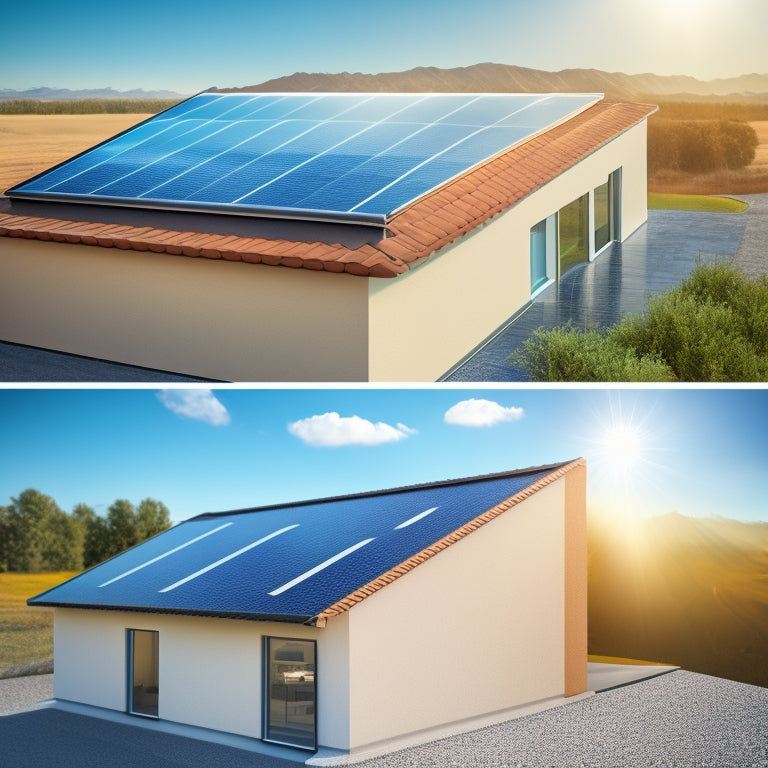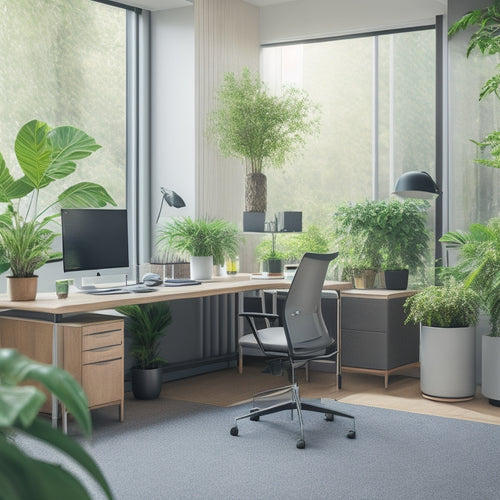
What Makes Reflective Roof Coatings Effective for Energy Savings?
Share
By applying high-albedo reflective roof coatings, you can decrease your roof's surface temperature by up to 50°F (28°C) during peak summer months, markedly reducing indoor temperatures and energy bills in urban areas. These coatings effectively reflect about 70% of incoming solar radiation, minimizing heat gain and leading to substantial energy conservation. As a result, your cooling system load decreases, reducing energy consumption and costs. With reduced heat gain and energy savings come several benefits, and understanding the full scope of these advantages can help you make informed decisions about your roof's energy efficiency – and there's more to investigate.
Key Takeaways
- High-albedo coatings reflect up to 70% of incoming solar radiation, reducing heat gain and energy consumption.
- Lower rooftop temperatures decrease indoor temperatures, leading to significant energy savings and reduced cooling loads.
- Reflective roof coatings minimize heat absorption, allowing cooling systems to operate more efficiently and reducing energy bills.
- By reducing heat gain, high-albedo coatings decrease the need for air conditioning, resulting in lower energy consumption and costs.
- Effective reflective roof coatings can decrease rooftop temperatures by up to 50°F, leading to substantial energy savings and conservation.
High-Albedo Coatings Reduce Heat Gain
In urban areas, the summer sun can turn your roof into a sweltering heat absorber, causing indoor temperatures to soar and energy bills to skyrocket. You can combat this phenomenon by applying high-albedo coatings to your roof. These coatings reduce heat gain by reflecting a significant portion of incoming solar radiation. As a result, your roof's surface temperature decreases, reducing heat absorption.
Additionally, incorporating solar energy solutions can provide supplementary power, extending vehicle range and reducing reliance on fossil fuels. Studies have shown that high-albedo coatings can lower roof surface temperatures by up to 50°F (28°C) during peak summer months.
Cooling Effect on Building Envelope
Three key components of a building's envelope - walls, windows, and roofs - are greatly impacted by high-albedo coatings.
You'll find that these coatings considerably reduce the temperature of your building's envelope, leading to improved thermal comfort and reduced cooling loads.
By incorporating renewable energy sources into building design, such as solar panels, the rooftop temperature can decrease even further.
In building design, incorporating high-albedo coatings into your roof can decrease the rooftop temperature by up to 50°F, lessening the heat gain that occurs when sunlight hits your building.
This, in turn, reduces the load on your cooling system, allowing it to operate more efficiently.
Energy Efficiency Through Reflection
About 70% of the sun's energy is reflected by high-albedo roof coatings, which greatly reduces the amount of heat that's absorbed by your building.
This reflection of solar radiation leads to significant energy conservation. By minimizing heat gain, you can reduce the load on your cooling system, resulting in lower energy consumption and costs.
In addition, integrating solar-powered charging solutions and energy storage systems can further enhance energy efficiency and reduce reliance on traditional power sources.
In turn, this decreases your reliance on non-renewable energy sources, contributing to a more sustainable future.
As you aim for energy independence, reflective roof coatings can be an essential component of your strategy.
Urban Heat Island Mitigation Benefits
By the 2040s, urban heat islands are projected to increase peak summer temperatures by up to 10°F, exacerbating the already significant challenges cities face in maintaining a comfortable and safe environment for their inhabitants. You can mitigate this issue with reflective roof coatings, which reduce the urban heat island effect by reflecting solar radiation and decreasing the amount of heat absorbed by buildings. This leads to improved thermal comfort and reduced energy consumption.
| Urban Heat Island Effect | Reflective Roof Coating Benefits |
| Increased energy consumption | Reduced energy consumption |
| Higher peak temperatures | Lower peak temperatures |
| Decreased air quality | Improved air quality |
| Increased heat-related illnesses | Reduced heat-related illnesses |
| Increased mortality rates | Reduced mortality rates
Long-Term Durability and Performance
As you implement reflective roof coatings to mitigate the urban heat island effect, it's equally important to contemplate their long-term durability and performance.
You'll want to guarantee the coatings can withstand harsh weather conditions, such as intense sunlight, heavy rainfall, and extreme temperatures. Look for coatings with excellent weather resistance, which can maintain their reflective properties over time.
Additionally, consider the maintenance requirements of the coatings. Some may need periodic cleaning or reapplication, while others can last for years with minimal upkeep.
Moreover, understanding the costs associated with solar panel recycling and other sustainable practices can help businesses make informed decisions about their energy-efficient investments.
Frequently Asked Questions
Can Reflective Roof Coatings Be Applied to Existing Roofs?
You'll be pleased to know that 90% of existing roofs can be retrofitted with reflective coatings. When applying these coatings, you'll reap application benefits by guaranteeing proper surface preparation, which involves cleaning and repairing the roof to secure a strong bond between the old surface and new coating.
Are Reflective Roof Coatings Suitable for All Types of Buildings?
You'll find that reflective roof coatings are suitable for most buildings, but their application suitability depends on the building materials used, such as asphalt, metal, or concrete, and the coating's compatibility with these substrates.
How Long Does It Take to Install Reflective Roof Coatings?
You'll typically spend 1-3 days on the installation process, depending on roof size and complexity, with a standard installation timeline of 5-7 business days from preparation to completion, ensuring a hassle-free experience.
Can I Apply Reflective Roof Coatings Myself?
While you're tempted to take the reins, it's advisable to exercise caution: DIY application of reflective roof coatings can be a complex, hazardous process, and overlooking essential safety considerations could lead to subpar results and even accidents.
Are Reflective Roof Coatings Resistant to Mold and Mildew?
You'll be relieved to know that reflective roof coatings are indeed resistant to mold and mildew, thanks to their water-repellent properties and additives that inhibit microbial growth, ensuring a durable, low-maintenance roofing solution that frees you from frequent cleaning and repairs.
Related Posts
-

3 Best Eco-Grants for Home Energy Upgrades
You're eligible for various eco-grants that can help you cut down on energy bills and reduce your carbon footprint by...
-

10 Best Energy-Efficient External Hard Drives for Sustainable Offices
When it comes to sustainable offices, you need external hard drives that balance data storage needs with energy effic...
-

What Air Purifiers Save Energy in Work Areas?
You can cut energy costs and reduce your carbon footprint by choosing air purifiers designed with energy efficiency i...


